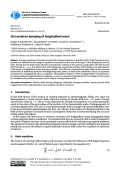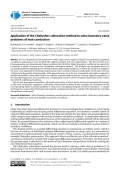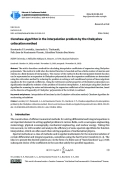Average equations of motion of relativistic charged particles in the field of HF (high frequency) wave packets are obtained in the range of cyclotron resonance in the case of strong LF (low frequency) electric field. Strong electric field means that the characteristic velocity of the particle comparable with the electric drift velocity (
For one-dimensional inhomogeneous (with respect to the spatial variable) linear parabolic equations, a combined approach is used, dividing the original problem into two subproblems. The first of them is an inhomogeneous one-dimensional Poisson problem with Dirichlet–Robin boundary conditions, the search for a solution of which is based on the Chebyshev collocation method. The method was developed based on previously published algorithms for solving ordinary differential equations, in which the solution is sought in the form of an expansion in Chebyshev polynomials of the 1st kind on Gauss–Lobatto grids, which allows the use of discrete orthogonality of polynomials. This approach turns out to be very economical and stable compared to traditional methods, which often lead to the solution of poorly defined systems of linear algebraic equations. In the described approach, the successful use of integration matrices allows complete elimination of the need to deal with ill-conditioned matrices.
The second, homogeneous problem of thermal conductivity is solved by the method of separation of variables. In this case, finding the expansion coefficients of the desired solution in the complete set of solutions to the corresponding Sturm–Liouville problem is reduced to calculating integrals of known functions. A simple technique for constructing Chebyshev interpolants of integrands allows to calculate the integrals by summing interpolation coefficients.
The article describes a method for calculating interpolation coefficients of expansion using Chebyshev polynomials. The method is valid when the desired function is bounded and has a finite number of maxima and minima in a finite domain of interpolation. The essence of the method is that the interpolated desired function can be represented as an expansion in Chebyshev polynomials; then the expansion coefficients are determined using the collocation method by reducing the problem to solving a well-conditioned system of linear algebraic equations for the required coefficients. Using the well-known useful properties of Chebyshev polynomials can significantly simplify the solution of the problem of function interpolation. A technique using the Clenshaw algorithm for summing the series and determining the expansion coefficients of the interpolated function, based on the discrete orthogonality of Chebyshev polynomials of the 1st kind, is outlined.
Earlier we developed a stable fast numerical algorithm for solving ordinary differential equations of the first order. The method based on the Chebyshev collocation allows solving both initial value problems and problems with a fixed condition at an arbitrary point of the interval with equal success. The algorithm for solving the boundary value problem practically implements a single-pass analogue of the shooting method traditionally used in such cases. In this paper, we extend the developed algorithm to the class of linear ODEs of the second order. Active use of the method of integrating factors and the d’Alembert method allows us to reduce the method for solving second-order equations to a sequence of solutions of a pair of first-order equations. The general solution of the initial or boundary value problem for an inhomogeneous equation of the second order is represented as a sum of basic solutions with unknown constant coefficients. This approach ensures numerical stability, clarity, and simplicity of the algorithm.



